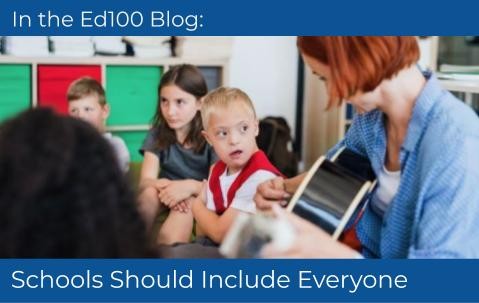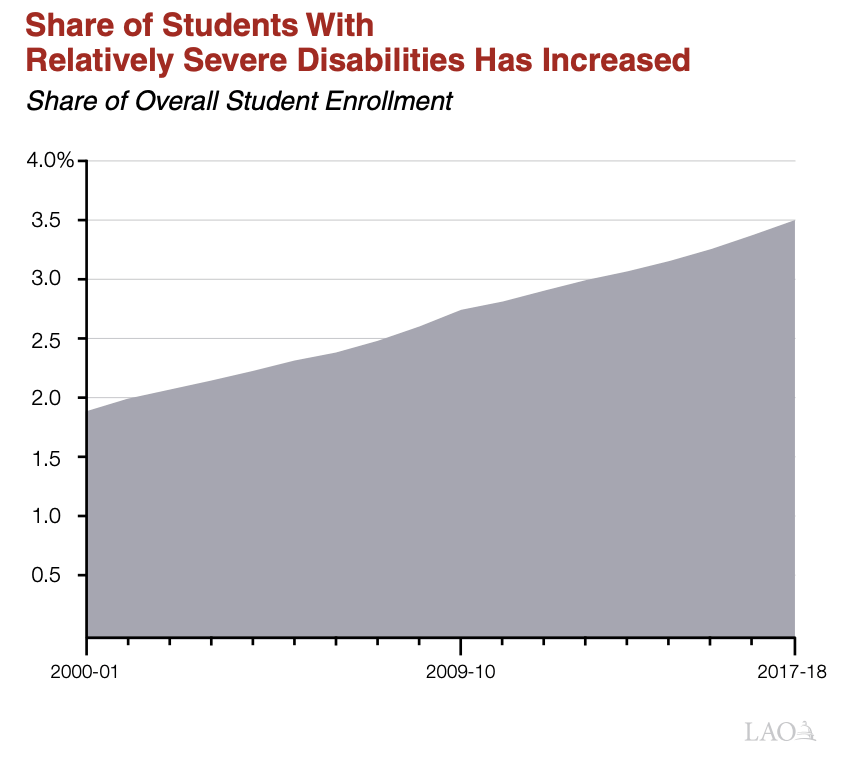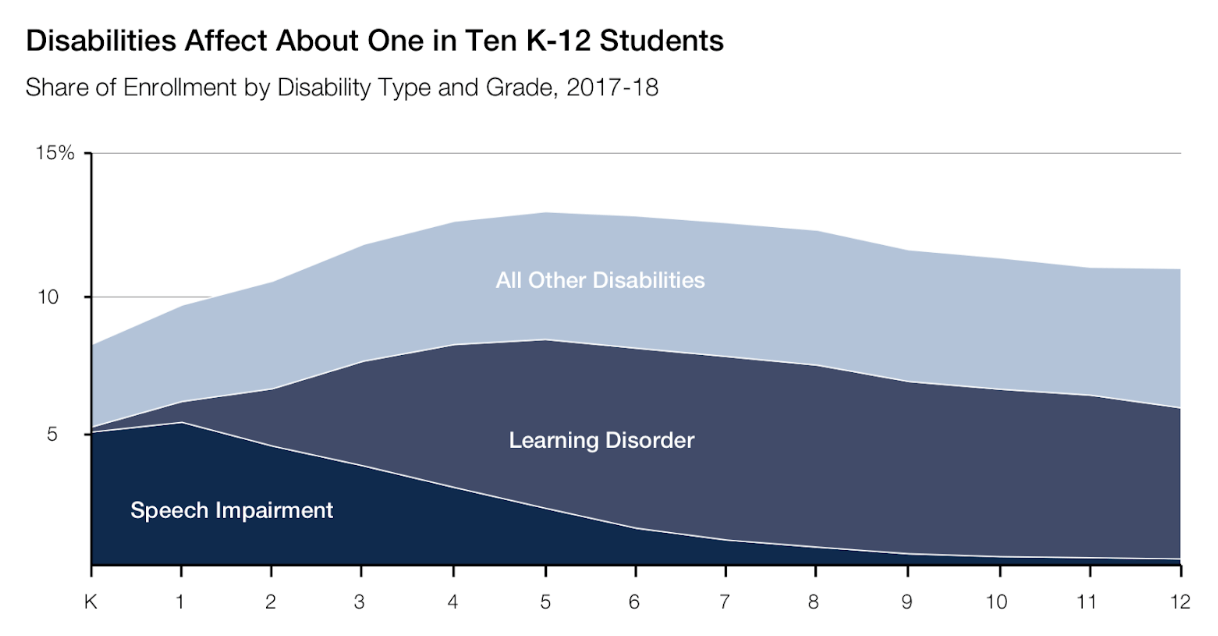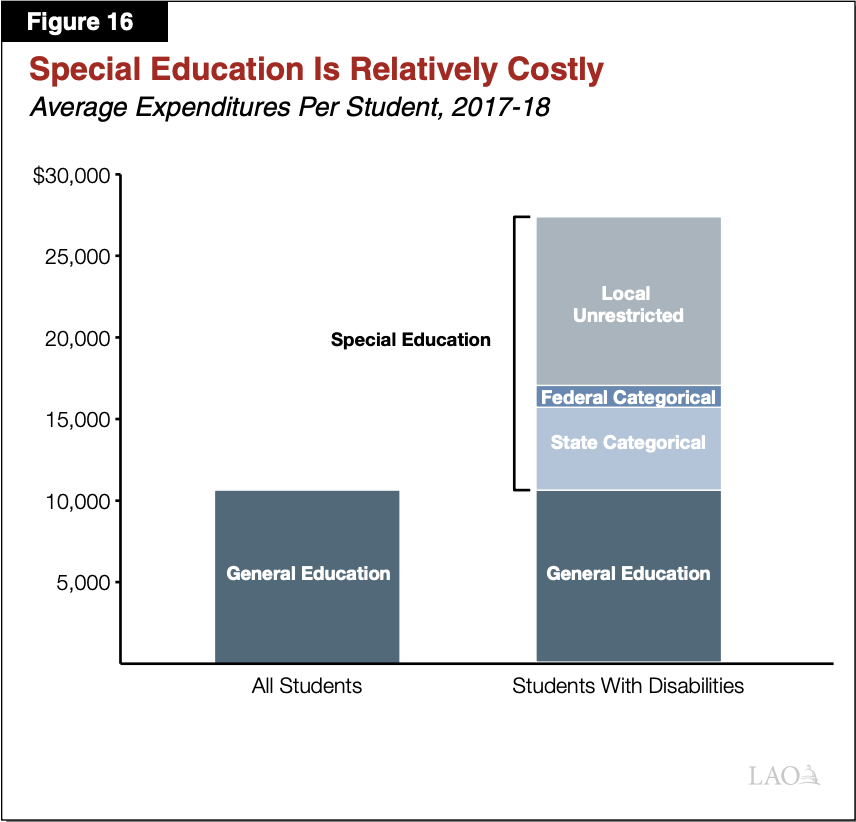
Disabilities that affect learning are common. About one student out of eight in the US formally qualifies for some form of help to support their learning needs.
In This Lesson
Who notices disabilities?
How do schools teach kids with dyslexia?
How do schools teach kids with autism?
How do schools teach kids with attention issues?
How can learning disabilities be evaluated?
What do school counselors do?
What is Section 504
How does IDEA relate to special education?
What's the difference between an IEP and a 504 plan?
What is Least Restrictive Environment?
How costly is it to teach students with disabilities?
Who pays for the cost of special education?
How does LCFF address special education?
What are SELPAs and how do they work?
Do gifted students get special education?
What tests do special education students take?
★ Discussion Guide.
The public education system is designed to serve all students, without exception. Both federal and state laws define and protect this mission. This lesson of Ed100 summarizes how schools serve students with special needs.
How are student disabilities identified?
Some forms of disability are easy to describe, like deafness, blindness or mobility issues. But most common challenges, including dyslexia, dyscalculia, and autism, require time and expertise to diagnose. The majority of students who qualify for special education services either have a speech impairment such as stuttering or a learning disorder such as dyslexia.
Parents: You are your child's most important advocate.
Parents: it is your job to figure out if your child needs help, and the earlier the better. Let your teacher know as soon as possible if your child is struggling or you suspect there may be a disability. Unfortunately, too many students are not identified quickly enough and miss timely early intervention. You are your child's most important advocate, and it can be a complex role.
What is Dyslexia?Many people are very smart and also have a learning disability. For example, Gavin Newsom, the governor of California, is known for his deep command of budget details. He is also famously candid about the fact that he has dyslexia, a common disability that makes reading difficult. As much as a fifth of humanity has some form of dyslexia, mostly undiagnosed. Like many people, Governor Newsom didn't discover that he has dyslexia until he was an adult.
The state of California took an important step in 2023 by committing to routinely screen all students in grades K-2 for risks of dyslexia and other reading issues so that teachers can help students address it. Compared to other states, California was a latecomer to this policy, which is for implementation in 2025-26. The screening tools are being developed for both English-speaking and for non-English-speaking students.
For decades, students were taught to read using a whole language approach that was demonstrably disastrous, particularly for students with dyslexia.
California teacher preparation programs are now required to replace outmoded teaching strategies with new literacy standards and Teaching Performance Expectations that focus on foundational reading skills such as phonological awareness, phonics, word recognition, and fluency. They also incorporate the California Dyslexia Guidelines.
What is Autism Spectrum Disorder (ASD)?A growing number of children, disproportionately boys, have a disability in a broad category known as Autism Spectrum Disorder (ASD), which affects behavior, communication, and interaction with others. Some people with severe autism struggle to function without considerable support. Others who are "on the spectrum" can be very high-functioning or brilliant. Elon Musk famously revealed that he has Asperger's Syndrome in his opening monologue for Saturday Night Live.
Kids on the ASD spectrum usually have difficulty "reading" others. They are disproportionately involved in bullying incidents, usually but not always as the victim.
What is ADHD?Less than a tenth of children have Attention-deficit/hyperactivity disorder (ADHD), which interferes with a child's capacity to consciously choose and control where they direct their attention. The hyperactive flavor of ADHD tends to particularly concern educators because students can distract others and complicate efforts at classroom control, especially in large classes.
Other issuesMany other disorders and challenges can interfere with education, from anxiety to depression to trauma. But for now let's move to the next step: When a parent or educator suspects that a student has a disability that interferes with their education, how are schools meant to respond?
What is Special Education?
Schools are obligated under law to provide special support for students who are identified as needing it. In education lingo, the term for this kind of help is accommodations and modifications. In California in 2022-23, special education services were provided to over 800,000 individuals, newborn through twenty-two years of age. Services are available in a variety of settings, including day-care, preschool, regular classrooms, classrooms that emphasize specially designed instruction, the community, and the work environment.
Early identification and support for struggling students is essential, but how does that actually happen?
In practice, most learning disabilities are first spotted by parents or by elementary school teachers in regular classrooms. In schools fortunate enough to have them, counselors can help enormously. With the permission of parents, psychologists assess a student to help determine if the child is eligible for special education. After that, the psychologist works with the classroom teacher and other professionals to determine what services the child needs. Sometimes the level of help required can be provided by teachers, such as allowing a student extra time to complete work. In other cases, the help required calls for more expertise. A necessary early step is an evaluation to determine whether the student is eligible for Special Education or a 504 plan.
|
Individuals with Disabilities Act (IDEA) |
|---|
|
Commonly known as Special Education, the Federal IDEA law governs how states and public agencies provide early intervention, special education, and related services to about 7.5 million eligible infants, toddlers, children, and youth with disabilities nationally. A major feature of this law is the requirement to develop an annually-updated Individualized Education Plan (IEP) for qualified students. |
|
Section 504 |
|
Named after a provision in the federal Rehabilitation Act of 1973, "Section 504" is a civil rights law that (among other things) prevents discrimination in access to education due to a disability. Who may be eligible for extra help? Examples include students with a physical or mental impairment that may interfere with a "major life activity" like reading, walking, concentrating, speaking, or breathing. Think asthma or an illness like arthritis. Even students that earn good grades may be eligible. |
Each of these laws has separate eligibility requirements. A student who is not eligible for special education may be eligible for a 504 plan. (Yes, this is part of the reason why some parents become education policy nerds.) Check this useful summary that lays out the differences.
Partly in recognition of the challenges that special education inflicts on families and educators, a task force of California leaders made efforts to reform processes into One System, with some success.
Practical advice
If your son or daughter needs special education services, it can be very helpful to keep good records including things like contact information, notes from meetings with teachers, and report cards. For guidance about what good notes look like for a parent of a student with a disability or disorder, watch this video from Understood.org.
Students with disabilities are included in annual state testing. Students can be given extra time or other accommodations (such as having the test read to them) so they can participate in and complete the test. Some disabled students take a different test, the California Alternate Assessment (CAA). (See Lesson 9.3 for more.)
What does Least Restrictive Environment mean?
Under special education law, all students are general education pupils first, including those with disabilities. Inclusion in general education classrooms should be considered the first setting for all pupils. This idea is commonly referred to as placing a student in the least restrictive environment. A majority of students with disabilities (almost 57 percent) are taught in general education classrooms for at least 80 per cent of the school day.
Special classes, separate schooling, or other removal of a student with exceptional needs from the regular educational classroom should only occur if education in the regular classes with supplementary aids and services cannot be achieved satisfactorily.
In 2022, research confirmed that the best way to serve students with disabilities is in general ed — not siloed in special education classrooms. “Students with disabilities spending 80% more time in inclusive classrooms did better in reading and math than peers spending more time in special education classrooms.”
What is Universal Design for Learning (UDL)
Great teachers get students involved in their own learning, permitting them to show their understanding in different ways. The 2015 Every Student Succeeds Act (ESSA) mentions this approach using the term Universal Design for Learning (UDL). The big idea is that UDL, executed well, can enable teachers to support students with varying needs in the same classroom. ESSA did not attach new funds or incentives to the UDL approach, but its use of the term raised its profile. Critics of UDL argue that there is little evidence to support it.
A cloud of evolving terminology surrounds the overlapping ideas about how to address students' learning needs. Everyone learns a little differently. For some, learning a melody is easy, but mastering a math concept is hard. For some, math is easy but names are hard to remember. Some teachers use the term learning differences in order to include everyone in discussion of how students might need support in flexible ways.
The costs of Special Education
Students with special education needs have a legally-enforceable right to accommodations. School districts and charter schools are obligated under law to provide a "free appropriate public education" to all students. If students don't receive the help they are due, they can sue for damages. It happens.
The cost of providing special education accommodations has risen over time, driven in significant part by increasing rates of severe autism. In late 2019, the California Legislative Analyst Office delivered an overview of special education systems to provide lawmakers with high-level policy guidance. It's a really important report, rather overlooked because it arrived at about the same time as a certain virus.
Among other findings, the report documents an important pattern about the grade in which schools identify student disabilities. By discovering issues earlier, districts can address them earlier and more effectively.
States use varying processes to identify students that qualify for accommodations, and the percentage of students identified varies, too. Nationally, about 15% of students have an IEP. California districts identified fewer special education students, about 13% of enrollment in 2020, according to KidsData.org. (Note: This was the most recent data available as of March 2024. Kidsdata draws on data from NCES at a slight lag.)
According to the LAO report, the average annual cost of educating a student with disabilities is almost triple the cost to educate a student without disabilities.
Both the federal and state government commit funds specifically for special education, in recognition of the mandate placed on school districts to serve students. These funds don't fully cover the costs, and the portion of the cost of special education that is locally funded grew from 49 percent of the cost in 2007-08 to 61 percent in 2017-18. The unreimbursed portion is sometimes insensitively called encroachment or encumbrance, terms that irritate families whose children have special needs.
Federal and state funds specifically for special education don't fully cover the costs. Local funds contribute, too.
Since 2019‑20, the state has increased special education base funding by almost $1 billion (30 percent) beyond annual cost‑of‑living and attendance adjustments. The corresponding statewide base rate grew from $557 per student in 2019‑20 to $715 per student in 2021‑22. The state budget for 2022-23 added about $150 per student for special education.
Special education is funded as a block, not per student
The state funding model (LCFF) doesn't include special education.
In California, money is allocated to school districts based on some student attributes, but disability status is not among them. In effect, this policy assumes that students with special needs are evenly distributed among the general population. The logic of this policy is to avoid creating incentives to label kids, but it’s a flawed assumption with an unequal impact.
Additionally, the policy creates a bittersweet problem for schools that do a great job of educating students with disabilities. If their success becomes well known, eventually they will attract more families that want a great program for their kids. Money does not follow the student. A school can become a victim of its own success.
What's a SELPA?
To help mitigate these financial impacts, and also to create some economies of scale for uncommon and high-cost disabilities (such as blindness), the state distributes disability funding through a regional network of Special Education Local Planning Areas (SELPAs.) State law requires that every school district, county office of education, and charter school belong to a SELPA. Most of the state's largest school districts have their own SELPA; smaller districts join together and negotiate the use of funds for students.
The SELPA system has many critics. A steady parade of reports has called for changes, so far without result, but the direction seems serious. For information about policy changes as they come (or don't), subscribe to EdSource. It's free.
The mysterious role of counselors, allegedly
Once upon a time, most schools had counselors.
Today, most California schools probably don't have any counselors at all. Access to school psychologists is likely even more scarce. This partly explains the state's relatively low rate of identification of students qualified to receive special education services. If a tree falls in the forest and no one is there to hear it, does it qualify for special education?
Why "probably" and "allegedly"? Because data collection about staffing in California schools is appalling. It's a tragic example of California's Alpha Centauri data system. As of October 2023, the freshest available count of school counselors was four years out of date, like a time capsule from Alpha Centauri. For what it's worth, the latest news from Alpha Centauri indicates that in 2018-19, well before COVID-19 was a thing, districts reportedly employed just 10,416 counselors in the entire state, but maybe that number wasn't much good, either. Someone in Sacramento might have more current and convincing data, but if they do they aren't talking.
What about gifted students?
“Gifted” does not fall into one of the 13 classifications of special education. However, being gifted does not disqualify a student from special education or 504 services. These children are referred to as twice exceptional.
Unfortunately, a child's giftedness” may mask a disability, or in reverse, the child’’s disability may mask the child’s giftedness. Because of a disability, a gifted student may be thought of as lazy or struggling. More on this subject in the Ed100 blog.
The special learning needs of gifted students are frequently overlooked. Some school districts set aside money to create programs or services for them, but there is no special funding in California to do so. Learn more about gifted students in the Ed100 blog.
This lesson was last updated in March 2024.
CHAPTER 2:
Students...
-
Students...
Overview of Chapter 2 -
Diversity
The Changing Face of America's Students -
Poverty and Race
How Do Students' Backgrounds Affect Their School Performance? -
Health and Education
What Can Schools Do? -
The Role of Parents
Education and Families -
How Does Education Change
Inputs and Outcomes -
Motivation
What Motivates Students? -
Special Education
Why Not Teach All Kids Alike? -
Child Protection
Intervention and foster care -
Undocumented Students
Education vs. Documentation -
Student Leadership
Student Voice in Schools
Related
Sharing is caring!
Password Reset
Search all lesson and blog content here.
Login with Email
We will send your Login Link to your email
address. Click on the link and you will be
logged into Ed100. No more passwords to
remember!




















Questions & Comments
To comment or reply, please sign in .
Carol Kocivar April 12, 2025 at 8:01 pm
"The IDEA, a landmark law passed in 1975, guaranteed children with disabilities access to free public education. Still, schools are struggling with funding as Congress has never met the goal of covering 40% of the extra costs. Funding now covers just 10%, prompting calls for more federal support."
Jeff Camp - Founder October 25, 2023 at 7:49 am
Jeff Camp - Founder February 24, 2023 at 3:06 pm
Carol Kocivar January 9, 2023 at 4:00 pm
One size does not fit all – inconsistent effects of inclusion on learning and psychosocial adjustment of children with special needs. Many disability advocates disagree .https://hechingerreport.org/proof-ponts-new-research-review-questions-the-evidence-for-special-education-inclusion/?utm_source=The+Hechinger+Report&utm_campaign=356ffc7a83-EMAIL_CAMPAIGN_2023_01_06_07_46&utm_medium=email&utm_term=0_-356ffc7a83-%5BLIST_EMAIL_ID%5D
Carol Kocivar August 4, 2022 at 12:55 pm
The special education base funding now calculated at the local level, rather than the SELPA level.
Increased ($14 million on going) and consolidated extraordinary cost pools.
Beginning in 2023-24, allocating Educationally Related Mental Health Services funding directly to local educational agencies rather than to SELPAs.
Developing addition to Local Control and Accountability Plan to support inclusive planning and promote cohesion between special education and general education planning.
Focusing a special education IEP best practices, and establishing an expert panel to continue the work of creating a model IEP template.
Establishing a pathway to a diploma for students who take the California Alternate Assessment and providing resources to identify alternative coursework options for students with disabilities to demonstrate completion of the state graduation requirements.
Carol Kocivar August 4, 2022 at 1:01 pm
Carol Kocivar June 14, 2022 at 12:47 pm
December 17, 2021 - This brief provides background on the state’s current funding allocation formula for special education, describes funding formulas used in other states, establishes a framework for evaluating these formulas, and offers some issues for the Legislature to consider.
https://lao.ca.gov/reports/2021/4486/spec-ed-funding-models-121721.pdf
Carol Kocivar June 5, 2022 at 3:26 pm
Important findings that " on average, states with proportionally larger populations of children and children living in poverty, children identified for special education, and non-White and Black children receive fewer federal dollars, both per pupil and per student receiving special education.
https://www.edworkingpapers.com/sites/default/files/ai22-578.pdf
Carol Kocivar May 14, 2022 at 1:56 pm
https://www.ed.gov/news/press-releases/us-department-education-announces-intent-strengthen-and-protect-rights-students-disabilities-amending-regulations-implementing-section-504?utm_content=&utm_medium=email&utm_name=&utm_source=govdelivery&utm_term=
Sonya Hendren July 11, 2020 at 1:23 pm
afrinier February 16, 2020 at 11:35 am
DerekandRebeccasDad November 21, 2019 at 10:53 pm
Jamie Kiffel-Alcheh October 25, 2019 at 9:24 pm
Jeff Camp January 6, 2020 at 11:27 pm
Selisa Loeza October 22, 2021 at 9:14 pm
Carol Kocivar May 28, 2018 at 9:54 am
Read the Ed100 is brief
Carol Kocivar March 3, 2018 at 5:05 pm
History of Special Education Funding
Carol Kocivar January 14, 2018 at 10:45 am
"California currently provides early intervention services to more than 40,000 infants and toddlers with special needs. California’s system for serving these infants and toddlers involves three programs operated by two types of local agencies—schools and regional centers. Some parts of this system date back more than 35 years. During this time, the state has not regularly, or even periodically, evaluated this system. We undertook a comprehensive review and found California's bifurcated system results in notable service delays.
Read the Report:
Evaluating California's System for Serving Infants and Toddlers With Special Needs
Kenny May 9, 2018 at 11:33 am
Carol Kocivar September 19, 2017 at 11:43 am
(Note: the lesson was updated with this information)
Jeff Camp March 23, 2017 at 10:13 am
David Siegrist1 April 30, 2017 at 12:31 pm
Jeff Camp November 29, 2016 at 9:50 pm
As usual, EdSource boils it down: Under the recommendation, "State money for special education would be folded into the Local Control Funding Formula, completing [Governor] Brown’s goal of creating a unified funding system for all children."
Here's more about it:
PPIC report: http://www.ppic.org/main/publication.asp?i=873
Task Force recommendations: http://www.smcoe.org/about-smcoe/statewide-special-education-task-force/
EdSource summary: https://edsource.org/2016/send-special-ed-funding-directly-to-districts-not-regional-agencies-report-says/573361
Albert Stroberg May 1, 2016 at 6:12 pm
There may be a subset which really do improve & perhaps some who get nothing out of it. How do we identify those?
Jeff Camp - Founder April 28, 2016 at 11:39 am
kellysakir March 7, 2016 at 1:49 pm
Carol Kocivar November 14, 2015 at 10:58 am
1. Research:
Identifying children with dyslexia as early as first grade could narrow or even close the achievement gap with typical readers, according to a new study by researchers at the University of California, Davis, and Yale University. http://www.sciencedaily.com/releases/2015/11/151102184216.htm
2. Dyslexia California Law 2015:
AB 1369 requires the superintendent of public instruction to develop program guidelines for dyslexia. These will describe the characteristics typical of students with dyslexia and outline strategies to address them. They are expected to include information to assist educators in distinguishing between characteristics of dyslexia and characteristics of normal growth and development. http://www.leginfo.ca.gov/pub/15-16/bill/asm/ab_1351-1400/ab_1369_bill_20151008_chaptered.pdf
geecookie2011 April 18, 2015 at 7:53 am
I speak and come from a child who this is his desire to do to be part of and to go to school to truly and really learn. Notbe and feel limited.
Ms Helenmarie “Cookie” a mother of 4 with child living with DS T21 and other complications and a Grandmother of 4
amosmickey April 14, 2015 at 12:03 pm
Veli Waller April 3, 2015 at 9:36 pm
Mamabear March 19, 2015 at 5:19 pm
Carol Kocivar - Ed100 March 12, 2015 at 12:11 pm
The report recommends changes to seven parts of the educational system:
• Early Learning
• Evidence based schools and classroom practices
• Educator participation and professional learning
• Assessment
• Accountability
• Family and Student Engagement
• Special Education Financing
For more information, go to: http://www.smcoe.org/about-smcoe/statewide-special-education-task-force/
Brandi Galasso March 5, 2015 at 7:31 am
jenzteam February 27, 2015 at 10:18 am
RE bullying and counselors - I feel our school is great at addressing both. HOWEVER - that said, we only have 600 kids at our school. Not 4000 like the other public school we could have chosen. These high school numbers are insane and I would have home schooled if putting our son in a school with 4000 kids was my only option.
Sherry Schnell January 22, 2015 at 9:52 am
eastwestpa February 4, 2015 at 12:53 pm
jenzteam February 27, 2015 at 10:22 am